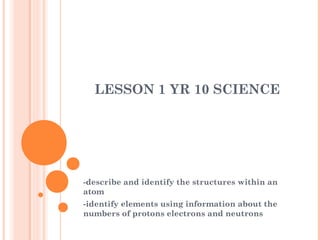
Lesson 1 yr 10 science structures within an atom
- 1. LESSON 1 YR 10 SCIENCE -describe and identify the structures within an atom -identify elements using information about the numbers of protons electrons and neutrons
- 2. DO NOW List all the things you can remember about atoms and molecules
- 3. ATOMS ARE NOT BOHR….ING Quick revision Bohr- Chadwick Model Atom was mostly empty space Atoms contained Protons, Electrons and Neutrons Atoms had invisible rings of force that held these things in place That the electrons in these rings can change their positions when they are part of a chemical reaction.
- 4. TEENY TINY INCY WINCEY THINGS Other wise known as ATOMS What is smaller than an atom? Structure of an atom Protons (protons) electrons (negative) Neutrons ???? YOU TELL ME.
- 7. STRUCTURE OF ATOM Depending on their energy they are locked into a certain area in the cloud. Electrons with the lowest energy are found in the energy level closest to the nucleus Electrons with the highest energy are found in the outermost energy levels, farther from the nucleus.
- 11. The Atom All matter is made up of atoms. The atom is the smallest particle of a matter. It cannot be broken down anyfurther by chemical means.
- 12. What is a molecule? A molecule is a particle with two more atoms chemically joined together, but not necessarily of different elements. The physical particle of a compound is called a molecule.
- 13. Work sheet time. Calculating neutrons Complete this worksheet now and finish for homework. Fredo’s for those that can complete the WHOLE sheet correctly.
- 15. CONSERVATION OF MASS Lesson 2 year 10
- 16. CONSERVATION OF MASS What’s wrong with Harry Potter?? You can’t make something from nothing. Why do we learn this?
- 17. THE LAW Antoine Lavoisier' Discovered the law The mass of a closed system must remain constant over time. Mass can not be created or destroyed only rearranged . Example: H22 + 0+ 022 2 H2 H2200
- 18. CONSERVATION OF MATTER EQUATIONS Balancing equations So we know that when chemical reactions take place chemicals are changed into new compounds. We show this symbolically using a chemical equation.
- 19. Balance it and make it Model experiment Aim: To understand the structure of compounds. You will be physically balancing the equation. Method: Each station will have a task card with a chemical formula and a large arrow. 1. Fill in the table before you start. 2. You are to make the structure of the formula 3. Keep the formula models on separate sides of the arrow 4. Using the conservation of mass theory try and balance the equation by building more elements .
- 20. Complete the organiser for each task Compound Name Number of each element NaNO3 Sodium nitrate Na N O PbO Lead Oxide Pb O
Editor's Notes
- By 20th Centery they knew that atoms were mostly empty space----draw circle with tiny dot They knew that atoms were made of stuff.
- All of this weighs something bc everything has mass. Protons and Neutrons weigh about the same but electrons are soooo light they are about 1800 times lighter than electrons.
- An atom on its own has a neutral charge of energy We know that they are made up of all these little things which all carry a charge It is the number of protons in the middle that determine what the atom is. Every atom has a different number of protons in the middle. The number of protons is called the atomic number
- Protons and electrons are equal so the element is stable and neutral. If the atomic number is the number of PROTONS in an atom. Atomic mass is the number of protons AND neutrons
- So you know about the structure of the atom now why do we even need to know this?
- Discuss what you need to create things What do you get when you make a reaction? Why do we learn this? Chemistry is really cooking in the lab. If I was to bake a cake all the ingredient I put in would equal the mass of the cake I got out of the oven. If I pulled the cake out and there was just this tiny cake I’d know that 1) I’m a terrible cook 2) that there has been a reaction of the ingredients and some have changed into gas or in this case probably a lot of smoke and ash. Chemistry is just like this I put in some ingredient and see what I get out on the other side. If what I get out doesn’t equal what I put in then what has happened to the other bits. As part of chemistry you need to be able to demonstrate what is happening in an equation so we can see that you are understanding the reactions that are taking place.
- Discuss example- write as a word equation Hydrogen plus oxygen equals dihydrogen oxide Draw the atoms out
- See sheet of chemical reactions
